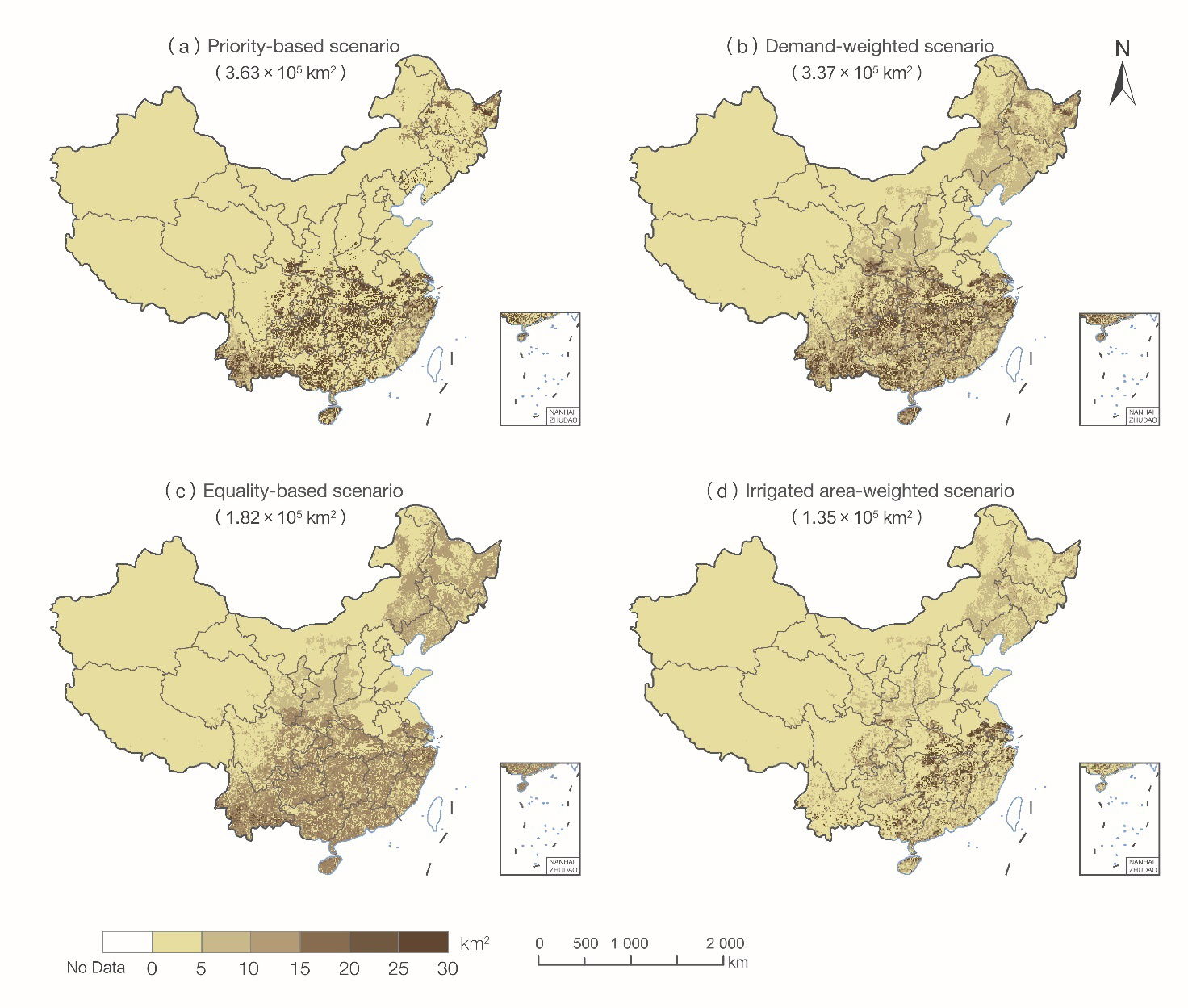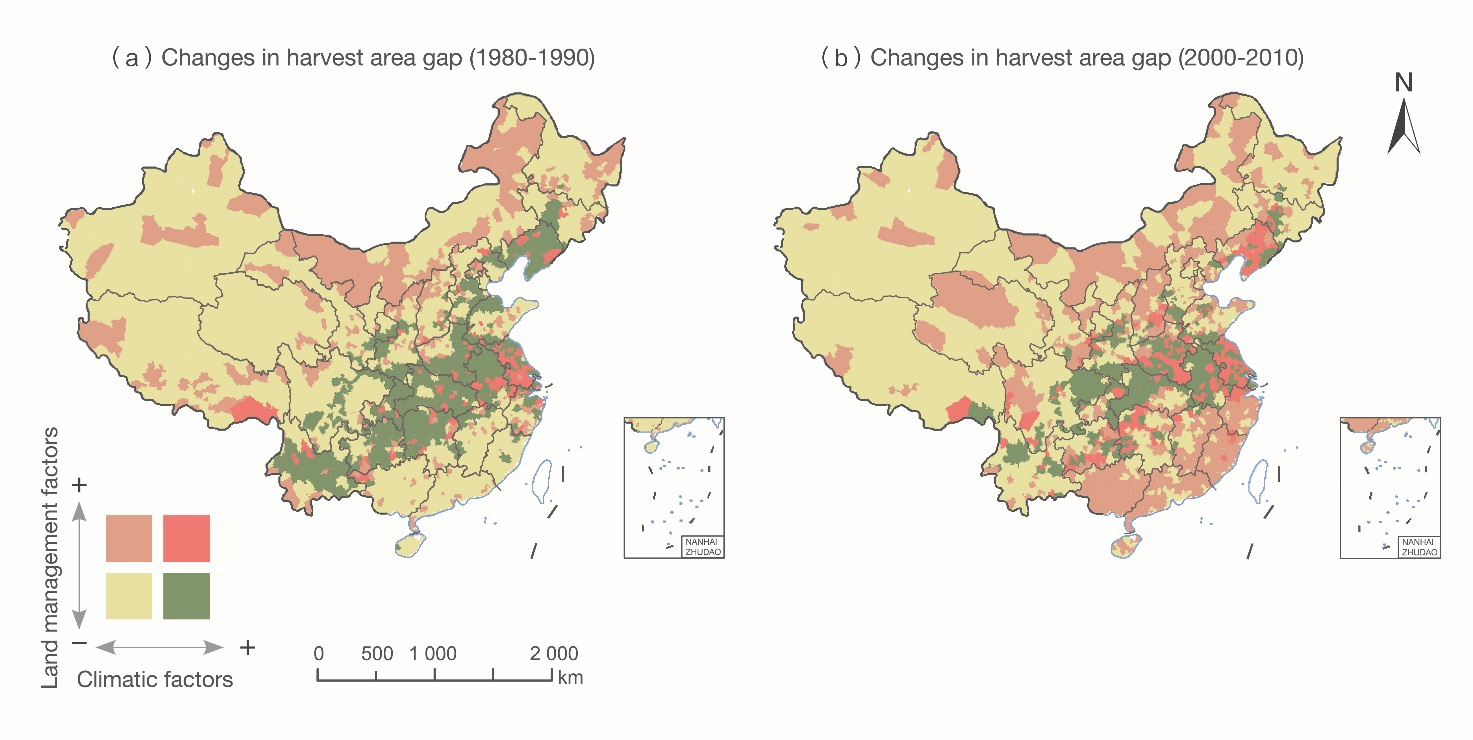SDG2: Zero Hunger
Potential for sustainable cropland intensification in China(2020)
Target: 2.4 By 2030, ensure sustainable food production systems and implement resilient agricultural practices that increase productivity and production, that help maintain ecosystems, that strengthen capacity for adaptation to climate change, extreme weather, drought, flooding and other disasters and that progressively improve land and soil quality.
| Highlights |
| China is able to increase its grain harvest area by about 1.35×105 to 3.63×105 km2 on existing cropland by increasing multiple cropping index. Under the most realistic scenario, grain production is expected to be increased by 19.6% . Cropland intensification is largely affected by water constraints: different scenarios affecting the variation of harvest area have given estimations up to 60%. Efficient allocation of resources is of utmost importance to cropland intensification. |
Background
Cropland intensification has great implications for global food security. Although global crop production has been doubled in recent decades by adopting high-yield varieties, yield stagnation has been observed recently in many places around the world, implying that crop yield is close to its potential limit and is difficult to further increase under the current circumstances (Ray et al., 2012). At the same time, it is unlikely to further expand cropland area as it is approaching the "planet boundary" (Henry et al., 2018). Constant human incursions into natural areas for agriculture will come at a hefty price. Consequently, sustainable cropland intensification by increasing multiple cropping on existing cropland is an alternative to improve global food security.
By using big Earth observation data, this case study presents an assessment of the potential for sustainable cropland intensification in China. It estimates the impact of increasing grain harvest area on existing cropland by increasing the adoption of multiple cropping activities. Moreover, it evaluates the pathways for sustainable intensification by considering water availability as an important environmental constraint.
Data used
①Spatial Production Allocation Model global gridded agricultural production dataset.
②National Land Cover Dataset, Global synergy cropland cover data.
③Climate Research Unit gridded climate dataset.
④Global Agro-Ecological Zones.
Method
Mapping current cropland use intensity. Considering the constraints of climate, soil, and crop suitability, the case study applies a minimum cross information entropy model to allocate crop area, yield, and total production from statistics to spatial grids by 10×10 km resolution. Furthermore, it maps the current cropland use intensity by aggregating harvested areas for grain crops.
Mapping potential cropland use intensity. The case study calculates the potential cropland use intensity according to two parameters: temperature and precipitation. The accumulated temperatures ≥ 3 400 ℃, 4 200 ℃, 5 200 ℃, and 6 200 ℃ are adopted for determining the thermal potential for multiple cropping, and the annual precipitation ≥ 500 mm and 1 200 mm are adopted for determining the water potential for multiple cropping.
Estimating harvested area gap with consideration for water availability. The harvested area gap is determined by dividing the potential cropland use intensity by the current cropland use intensity. Four water allocation scenarios are set to analyse the impact of water constraints on cropland intensification. These scenarios are named Priority-based allocation (grid cells with a higher intensity area gap are given the priority to receive water), Demand-weighted allocation (using grid level water demand under full intensification as weight), Equality-based allocation (irrigation water is equally distributed across grid cells), and Irrigated area-weighted allocation (using current irrigated area as weight).
Results and analysis
The current cropland area in China is approximately 1.31×106 km2, of which approximately 1.60×106 km2 harvests grain crops annually. The estimated harvested area gap in China ranges from 1.35×105 to 3.63×105 km2, which is comprehensively determined by climate resource potential and water allocation constraints (Fig. 1). In the most realistic scenario, the full exploitation of the harvested area gap can bring an extra grain production of approximately 1.17×108 t, which equals a 19.6% increase compared to the current national grain production level.
Although the total harvested area in China has been increasing steadily, the estimated harvested area gap first decreased then subsequently increased. The initial decrease was the result of an increase in the actual multiple cropping activities throughout the country, which was larger than the increase in the potential multiple cropping as a result of changed climatic factors. The subsequent increase in the harvested area gap is the result of a decrease in actual multiple cropping activities (e.g., land management factors), in combination with a stagnant potential (Fig. 2). In some southern regions, both climatic and land management factors have enlarged the harvested area gap, indicating that these areas should be prioritized for cropland intensification.

Figure 1. Harvest area gap in China regarding different water allocation scenarios

Figure 2. Changes in harvest area gap in China and the contributions from climatic and land management factors (Note: no data available for Taiwan province)
Outlook
With the target proposed by SDG 2.4, this case study aims to improve the productivity and sustainability of grain production systems in China. Relying on Big Earth Data, it investigates the potential for sustainable cropland intensification and finds that China has great potential to harvest more grain crops on its existing cropland by properly increasing multiple cropping activities. Making full use of this potential, on the one hand, increases crop production to eliminate hunger, and on the other hand, alleviates the environmental pressure caused by the expansion of cropland. However, the complexity of cropland intensification should be fully acknowledged in that it encompasses resource systems, environmental systems, and ecological systems. Resource-saving and environmentally friendly global agricultural production needs to be established for targeting SDG 2.4.

